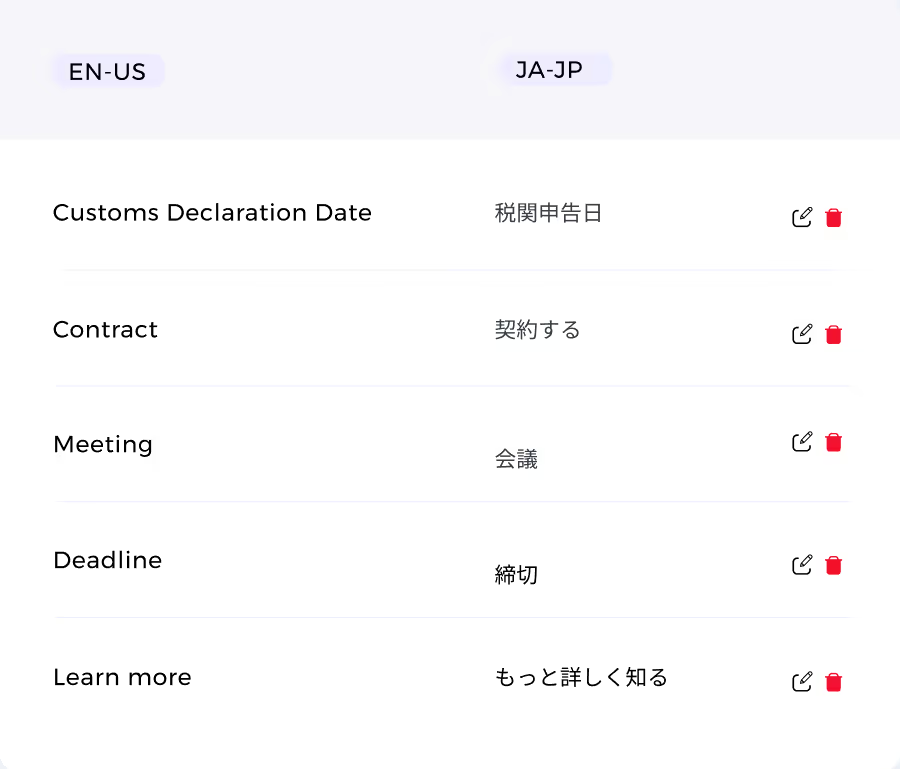Demystifying Multilingual Translation
Bureau Works guides you through internationalization with an end-to-end solution that works with your entire content ecosystem and automates many common tasks
Bureau Works guides you through internationalization with an end-to-end solution that works with your entire content ecosystem and automates many common tasks










A big part of how you approach multilingual translation is tied to the type of content you’re adapting. These will all have different quality requirements and challenges to consider as you undergo your project. While it’s impossible to categorize all the disparate types of content out there, much of it can be broken down into one of six overarching types.
In many cases, it’s possible to start an app translation off by using straightforward machine content and then scaling up quality based on the demand you see after it goes live. Early MT can also help you understand issues in your code that may impact the user experience and display of the content. Both iOS and Android offer solutions for localizing app content, so this doesn’t have to be a particularly challenging task.
Marketing materials can be very tricky to translate because you’re not just trying to convert content. You also must express the brand’s image. In some markets, you’re going to have to change it a bit to appeal to a new group of users. In many cases, translating marketing materials is about coming up with independent marketing plans for each region and using original content only as a jumping-off point.
Use-case is the key to understanding how to translate your website content. If it’s merely there to support an app, you may be able to get away with less robust strategies. If it’s an ecommerce site or something where it acts as the primary portal to your brand, you’re going to need a much more elegant localization solution. You’re also going to have to consider updates carefully. Some websites change every day; others stay the same for years. How often you update will play into the overall cost of localization maintenance.
Your corporate culture is a big part of your lexicon. Unfortunately, it can be challenging to translate that culture into new markets if you don’t set standards for communications. These standards include everything from managing company announcements to training international employees. You’ll need a well-trained machine translation to ensure that your culture is consistent regardless of the market.
Expertise is vital in any kind of technical documentation. Linguists will need to understand not just the languages, but also how your product or service works. In this, it’s imperative to work with a linguist who is familiar with your brand and industry. This individual should have a proven history of success so you can teach consumers about your product regardless of their language.
Interacting with customers in different markets can be a challenge because you’re not just dealing with text. You may have video or audio files that need to be translated to train workers and serve customers faster. In this, you’re going to need to work with a company that can provide multimedia solutions, rather than ones that strictly focus on content.

Many companies choose to go multilingual because they’ve grown as much as they can in their current market. This approach to global expansion often focuses on more of the “major languages” first without the consideration of other more niche options—which could be more appropriate and profitable for the content or product. Even with a multilingual strategy, it’s essential to establish market priorities and break translation down to quality tiers.
During this stage, you’ll have enough data to train your machine translation to provide better, more branded content. You’re still using machine translation, but it’s far more readable and natural than the content published under Tier I.
This is a sophisticated, full-on localization process that includes using human translators and in-country reviewers to ensure content is accurate and reflects the brand’s culture, values, and message.
At this level, you would use raw machine translation (MT) of content that’s rarely viewed by individuals and is unlikely to result in conversions. Translations will be available, but some statements may read as nonsensical or be unclear without the human context. With this route, it’s vital to add a disclaimer to make it clear a machine has translated the content.
Here, you can combine machine translation with a human editing process to fix syntax issues and clarify messages. This is great for managing marketing materials in areas where demand potential is there but you’re unsure of it.
Consider a situation where you’re starting with a Tier 1 translation of a technical manual for your product. You may notice a sudden jump in views or a lot of user reports requesting clarification. This should be a trigger to reprioritize that content to a higher level. Of course, how you prioritize that content will also depend on the type. There are some situations where you’ll need to go with the highest tier right at the start, like for internal communications or marketing materials.


An intuitive platform is one that will learn with you. As you correct translations, those corrections make their way into the translation memory to ensure that translators can be consistent and accurate in the future. Cloud-based programs help to continuously update systems and ensure the most recent corporate lexicon is always the one in use. Also, this platform should include CAT tools that make suggestions to translators based on those memories and corporate lexicons to both speed job completion and ensure greater accuracy.

The time it takes to assign a job to a translator can significantly delay a project. You should be able to assign and approve jobs based on given parameters with the click of a button. The program should match you with translators automatically based on that linguist’s prior success scores for similar projects. Mostly, you should have an end-to-end solution where every single job is handled inside the platform and then pushed live while eliminating mundane, time-consuming tasks best handled by a machine.

Your workflow should be something that updates in real-time to allow you to catch issues early. If you sign into a specific task and see that the translator is misusing a term, as an example, you can correct it before it trickles through all the languages and creates a much larger issue. Billing should be just as transparent. You should be able to submit a job and see—before anything starts—how much that job is going to cost based on the complexity, word count, and use of machine translation.



Contact our team for more information.



